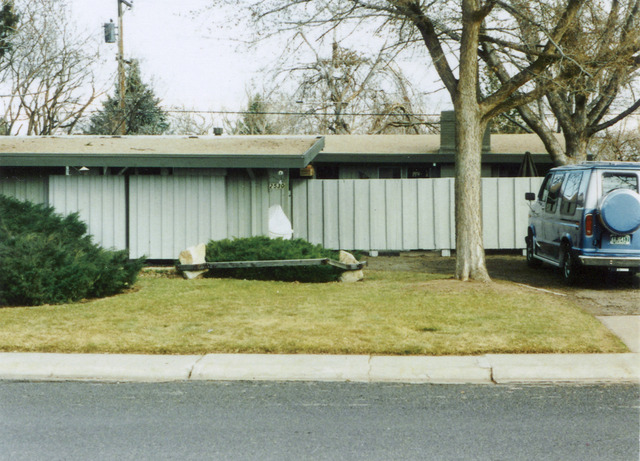The Local newsletter is your free, daily guide to life in Colorado. For locals, by locals.
It was 1955 when Bud and Phyllis Biltz toured a recently constructed midcentury modern model home in Denver’s Harvey Park neighborhood. Coming from a basement flat near the city, the open floor plan, floor-to-ceiling windows, and private courtyards were irresistible. They decided they had to have one.
“We just fell in love with the house,” Phyllis remembers. “We knew it would be tough, so we went home and just kept crunching numbers until we could make it work”

Bud is a Korean War veteran. He came home just two years earlier, which earned the couple financing assistance from the government, and they purchased the house that year for $13,500.
The Biltzs own one of 170 midcentury modern homes designed by Cliff May, a California contemporary architect, in Denver’s Harvey Park neighborhood, which sits south of West Jewell Avenue between South Sheridan and Federal boulevards.

Atom Stevens, who bought a May home in 2004, has since become Harvey Park’s resident historian, and has thoroughly researched the architect’s work. He’s found May’s designs across the U.S.—from Flint, Michigan to Tacoma, Washington—with the largest tracts being in the Golden State (although the Harvey Park area is also of notable size).
As tract homes, these homes started with a few model properties that interested buyers could tour and purchase a replica house. There were three color schemes to choose from, to be constructed by pre-fabricated walls, windows, and support beams. Denver Post ads from 1955 advertise the May homes costing between $12,750 to $16,750, with up to four bedrooms and two bathrooms.
Also dubbed “cookie-cutter homes,” tract housing developments such as these became popular in the ’50s and ’60s, around the same time that the midcentury modern style—commonly associated with Frank Lloyd Wright’s work—started to make a mark in architectural history. About 10 percent (around 450 homes) in Harvey Park are from the midcentury modern era, according to Stevens.
Adrian Kinney, a local real-estate agent and midcentury modern expert, has sold nearly 20 properties in Harvey Park since 2015 and is seeing both millennials and baby boomers seek out these properties, which are smaller (usually less than 2,000 square feet) and capitalize on multiple outdoor living spaces—fitting for the time period. “Modernism is about a lifestyle,” says Adrian Kinney, real-estate agent and midcentury modern expert. “It’s about outdoor living and being one with nature—and this kind of lifestyle is becoming more popular [today].”
When you walk inside the Biltzs’ home, it feels more like an atrium than a living room. Glass-pane walls look out into a private patio to the west and a fenced-in backyard to the east.
The walls are covered in Phyllis’s own artwork. She loves macramé and watercolor painting, to name a few mediums, and her sons have an eye for design, as well. They raised three boys in the three-bedroom home, who still come visit and help with the upkeep of the house. They’ve built stone fountains and iron benches together to adorn the outdoor living rooms where Bud and Phyllis drink coffee in the mornings and watch the sunset in the evenings.

“It’s why we fell in love with the house, all the outdoor space,” Phyllis says. Although raising the boys in a 1,000-square-foot home with one bathroom was tight, they were never willing to move.
Back in the ’50s, the neighborhood was full of new parents, with kids playing in the street and walking to and from school. Now, the neighborhood is booming again—but in a new way. Home prices for midcentury modern properties that hovered around $200,000 in 2015 are now surpassing $400,000, according to Kinney. Residents are seeing an increase in designers, architects, and artists inhabiting the neighborhood and taking note of its history.

Both Stevens and Kinney are interested in pursuing either a historic designation or conservation overlay for the May homes. Two separate applications sent through Denver’s Planning and Zoning Department focus on preserving the original styles and designs by implementing guidelines on exterior remodels and demolitions. The stark difference is that the historic designation prevents the homes from being demolished, and a conservation overlay does not.
“It’s about educating the community that this is a valuable thing to do,” Kinney says, noting that historic designations have been proven to increase home values. Late last year, city council approved a conservation overlay for one pocket of midcentury modern homes in Denver’s Krisana Park, south of Glendale. The guidelines set for any exterior construction or additions could serve as a model for Harvey Park.
Now in their 80s, the Biltzs are glad they never decided to move to a house with more indoor square feet and say they support some sort of official preservation with the city. “It’s why we stayed, because of the house,” Phyllis says. “We could have upgraded for more space, but we couldn’t find anything quite like this.”








